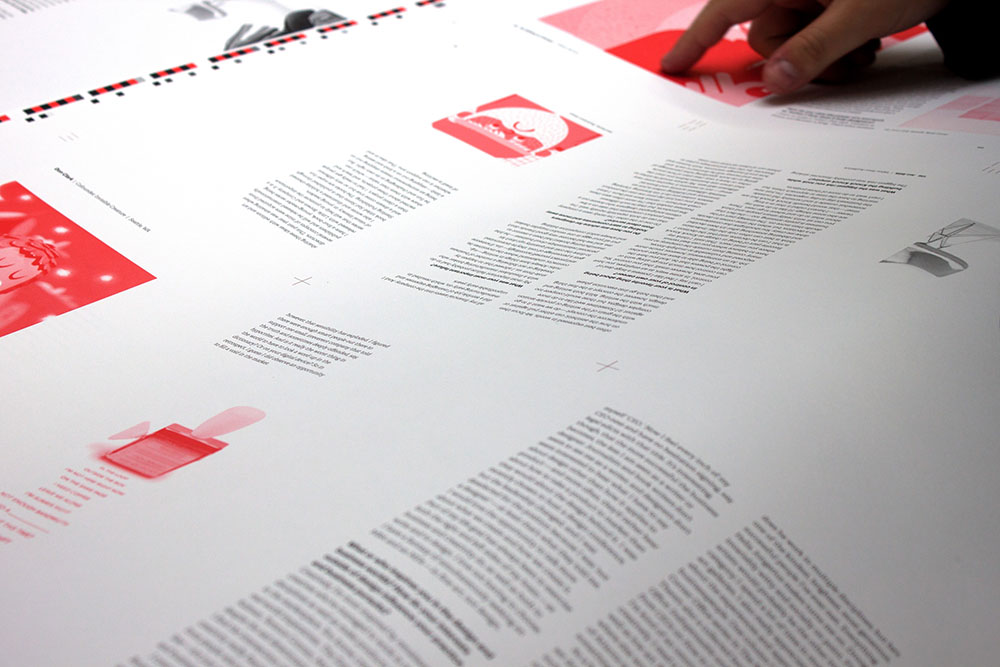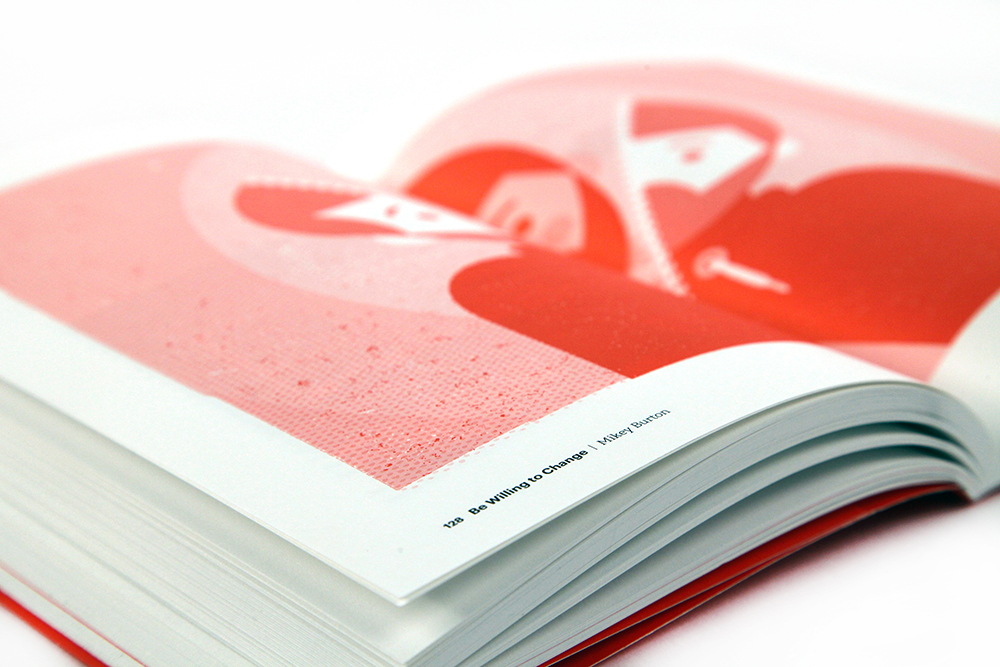“If you’re looking for a collaborator, find someone who challenges you to be better, and who you respect as a person, not just as a designer. It’s much easier if your skill sets compliment each other.”—Tim Hoover
Tim Hoover + Jessica Karle Heltzel: Kern & Burn / New York NY
kernandburnbook.com
“if you’re looking for a collaborator, find someone who challenges you to be better, and who you respect as a person, not just as a designer. it’s much easier if your skill sets compliment each other.”—tim hoover
Was collaboration a significant part of your background before Kern and Burn?
Tim: I studied fine art and design in undergrad. Design helped me get over the idea of the lone artist who hides in the woods for two years and then reveals his/her masterpiece. I ran a design firm called The Infantree before MICA. My two partners and I built a business, a gallery, and a brand together. None of us could have done that on our own. We benefitted from each other’s networks, but we also challenged one another to exit our comfort zone and test assumptions. I believe everything is a collaboration, whether it is a collaboration between a freelancer and a client, a teacher and a student, or two partners.
Jess: Prior to attending grad school for graphic design, I worked in a small architecture firm, thus collaboration was essential to success. As an interior architect and project manager there, I developed and maintained relationships not only with clients, but developers, contractors, engineers, etc.
Proof Check
courtesy of kern and burn
You’re in a top-notch graduate Graphic Design program, surrounded by rockstars and gear, perfectly positioned to achieve your specific dream project, only to highjack the opportunity and reroute it toward the collaborative Kern and Burn. What was the genesis of that decision?
Tim: We realized early on at MICA that the best part of the experience was being surrounded by a bunch of talented people from diverse backgrounds—all eager to improve themselves and save the world. You have two choices as a graduate student: you can boast your strengths and hide your weaknesses, or you can be honest with your classmates and be willing to learn from them. Learning from our classmates was the most inspiring part of graduate school.
When designers are vulnerable, they are more open to accepting critique. They no longer limit their view of the world, their biases, or their skills—they are able to make a much larger impact than they can by themselves. This is the reality of what it takes today.
Kern and Burn: Conversations with Design Entrepreneurs
courtesy of kern and burn
I came into graduate school looking for more ownership over my work, but instead I found the power in collaboration. As we each started developing and presenting our individual thesis projects, they didn’t feel like our own. Jess and I gravitated toward one another to brainstorm. We didn’t feel guilty for helping one another—in fact, we encouraged our relationship and relied on it. We challenged one another, and the project became something bigger than either of us could have built on our own. Little victories are so much more fun when you can share them and the failures are also a bit easier. Our collaboration forced us to communicate and defend decisions. Ergo, it takes trust in yourself and in the other person. It helps when a good collaboration has a sense of playfulness too.
Jess: Collaborating on a thesis project is fairly unheard of at competitive graduate schools. MICA does a wonderful job of accepting students from a wide range of backgrounds. Although students are also encouraged to pursue their personal goals full-force, collaborating on our thesis was a decision we didn’t take lightly.
Tim wanted to start a business, and I wanted to start a magazine. It was a natural partnership; it just took us a little while to come to the conclusion to take the leap and collaborate. We knew that we wanted to discuss topics relevant to designers interested in starting their own business—and in order to create something on that scale, we needed each other.
Kern and Burn: Conversations with Design Entrepreneurs
courtesy of kern and burn
Is there a link between your interest in entrepreneurship, design, and collaboration?
Tim: Definitely. It’s hard for me to separate entrepreneurship from design and collaboration because they all feel like the same thing. Design is the process through which we communicate and create value for others. Entrepreneurship is applying the right constraints on a problem to make it sustainable over time. It is also a lens to understand design through a more objective viewpoint. “Does it work?” is a much easier question to answer when there’s an audience to provide that feedback. Collaboration facilitates all of this and allows it to happen on a larger scale.
Jess: The dynamic of the collaborators is a key factor to whether or not a business succeeds. Many of the design entrepreneurs that we respect have partners who help them succeed, and what’s interesting is, the most successful partnerships are full of differences rather than similarities. Opposing qualities—such as a broad approach versus day-to-day details, technically minded versus artistic expression, messy studio space versus an organized desk—add up to form the bigger picture of a working relationship that is balanced by these variances.
Kern and Burn: Conversations with Design Entrepreneurs
courtesy of kern and burn
The success of our partnership has always worked because we are different. Tim and I have different technical skills, priorities, work methods, and stress-levels, but those differences work in our favor because they force us to challenge one another. We love the name Kern and Burn because it represents each of us so well: Jess is the Kern (detail and execution-oriented) and Tim is the Burn (ideation and big-picture).
Entrepreneurship and collaboration are linked through design for us. We believe that designers are perfectly positioned to be entrepreneurs. Designers have always partnered with their clients, and learn through others’ business ideas. Now, with the help of services such as Kickstarter, designers are in an easier position to take ideas of their own, rally the support of others, and launch their own ventures.
After conducting all of the interviews with design entrepreneurs, can you merge their advice with your own experiences to offer a list of principles for younger designers interested in launching some sort of collaborative?
Tim: Trust yourself—not because you have all of the answers, but because together, you and your friends are smart enough to figure it out. Time and time again, we heard through our interviews that designers learned as they went. 99% of people will never try the thing they really want to try. But designers set themselves apart by experimenting. Don’t quit your job today, but work on the weekend, and go after whatever you want.
Kern and Burn: Conversations with Design Entrepreneurs
courtesy of kern and burn
If you’re looking for a collaborator, find someone who challenges you to be better, and who you respect as a person, not just as a designer. It’s much easier if your skill sets compliment each other. Collaboration is hard, so it helps to do it with someone you believe in, and someone who has the same goals, work ethic, and humility that you do.
Jess: The best piece of advice given to me was to ask for advice. There’s no shame to reach out and discover how other people work. We asked designers about the origins of their businesses, how they balance work and life, how they make time for side projects, etc. Personally, I’ve learned so much just by taking the first step to ask questions. Asking led us to a series of casual interviews, which formed into a blog, then became the 100 Days of Design Entrepreneurship, where we collected a group of loyal followers, launched a successful Kickstarter campaign, and that enabled us to self-publish Kern and Burn: Conversations With Design Entrepreneurs. After the book was published, we spoke at conferences, and led workshops. We’ve been thinking a lot about what our purpose is as a business, as a platform, and as a resource. We landed on Kern and Burn: For Design Entrepreneurs. We want to continue growing a set of resources that positively influence people’s design careers and build communities.
Secondly, you don’t need new ideas. You need ideas executed extremely well. Many designers, ourselves included, tend to get stuck at the beginning of projects under the pressure of needing to come up with the newest or greatest idea that no one has ever thought of before. We came to realize that the idea itself doesn’t have to be new, it just has to be executed in a new way. As design entrepreneurs, that’s where the opportunity lies to combine your expertise and skill sets to create businesses and collaboratives that rise above the competition.
Nap in MICA GD Lounge
courtesy of kern and burn
What makes your collaboration function? How is your process unique?
Tim: I think we’re unique because we celebrate the successes of each other, and often promote the individual above the collaborative. We’d both rather see our collaboration blow up than our individual brands. We work hard to improve ourselves, but the end goal is how we can add value to each other and other collaborators, like our startup teams or our audience. We use our collaborative to support multiple other individual endeavors.
Jess: We argue a lot. But the arguments allow us to better understand the project in relation to where each of us stands. The honest discussions always make the project stronger and we’re always learning new things about each other. The best partnerships evolve as the partners and the products grow.





